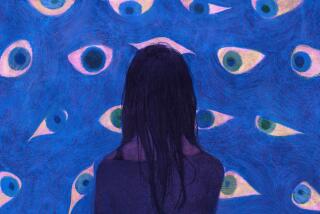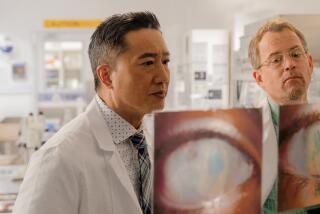Although He’s Lost His Sight, He’s Gained a New View
- Share via
John Cairns couldn’t believe it, but there it was.
Or, more accurately, there it wasn’t. He had the job application form right in front of him, but damn if he could see clearly enough to fill it out.
Denial is a powerful weapon, and Cairns had been doing some powerful denying. His sight had been degenerating for years, but he’d held onto a managerial position at a Garden Grove aerospace firm. More and more, though, he was taking papers home at night and having his wife help him read them.
When the company laid him off and he had to start fresh in the job market and do things like fill out applications, Cairns knew the game was over. At 46, with a wife and three kids, he had to face reality: He was legally blind. By his reckoning, the meaningful part of his life had all but ended.
That was four years ago.
Many of us play the “what if” game.
What if I were to get a terminal disease?
What if I lost a limb?
What if I went blind?
John Cairns is at peace today because he had to play for real. And he won.
“I had always been the gung-ho type,” he says, as we talk at arm’s length across a table. He has some vision but says he can’t distinguish my face. “Some people take years to get anywhere with dealing with vision loss. I played ‘poor me’ and ‘what am I going to do?’ for six months or a year, and then I just said, ‘My stomach is tied in knots; I feel like crap; I’m making everyone around me feel bad, and that’s no way to live the rest of my life.’ ”
So, he did “one of the hardest things I’ve ever done in my life,” which was to telephone the Braille Institute in Anaheim. His plea was simple: Help me.
“In my mind at the time, I felt I was giving up by calling Braille,” Cairns says. “I was still in denial. Braille? That’s where you go learn to read bumps. But I had no other option, so I said I’d go to Braille to read bumps. That was a real emotional thing for me.”
The Anaheim site is one of several in Southern California and served about 1,500 adults and children last year, according to director Sheila Daily. Most of the classes teach “coping skills,” both psychological and practical. Operated by 60 staffers and a phalanx of some 350 volunteers, the institute has both classroom areas and a Braille library with 12,000 titles.
With counseling at the institute and his family’s support, Cairns came all the way back. He realized that whatever kind of man he’d been before he lost his sight, he was still that kind of man. “For the most part, I’m a happy guy,” he says. “I thought my quality of life was gone forever and I’d be sitting in a corner waiting for someone else to take care of me for the rest of my days. I’m very grateful that Braille [the institute] showed me that doesn’t have to be.”
Three weeks from today, the institute will hold its annual benefit. It’s an important day for Cairns, who credits the institute as the place that “absolutely saved my sanity, if not my life.”
Cairns, who lives in Fullerton with his wife of 27 years, hasn’t taken another full-time job, mainly because he can’t find one that challenges him and pays what he thinks he’s worth. He and his wife have switched breadwinner and stay-at-home roles, and Cairns teaches two classes at the institute in an effort “to give something back.”
His successful transition to a life without sight is by no means universal. The U.S. Census Bureau says the number of blind people in Orange County is approaching 7,000, and Cairns laments the fact that sighted people tend to think the blind or near-blind “can’t really do anything.” It’s a fact that many of them won’t cope as well as Cairns. “I’ve always maintained,” Cairns says, “that the emotional baggage for vision loss was a bigger handicap that the vision loss itself.”
He says he’s conquered the demons, so I ask the indelicate question: How much do you miss not being able to see?
“It depends on what it is,” Cairns says. “I would like to be able to see my granddaughter’s face clearly. I can’t. I don’t love her any less, but I’d like to be able to see her better.”
He doesn’t miss driving, but he’s still a bit fearful when crossing the street. He still putters around the house, but fixing things takes longer than it used to. He still plays golf but no longer worries about keeping his head down. (“There’s no point in looking for the ball. I can’t see it anyway.”)
Naturally upbeat and driven, Cairns knows the second half of his life will be different than the first. Different, but not automatically worse. He has learned patience and dignity in the face of what most of us would consider an overwhelming loss.
“I looked at Braille as: This is the end,” Cairns says, just moments before he is scheduled to teach his next class at the institute. “Now I look at it like: Braille wasn’t the end; it was a new beginning.”
*
Dana Parsons’ column appears Wednesday, Friday and Sunday. Readers may reach Parsons by calling (714) 966-7821 or by writing to him at the Times Orange County Edition, 1375 Sunflower Ave., Costa Mesa, CA 92626, or by e-mail to dana.parsons@latimes.com


